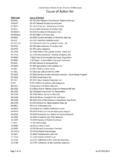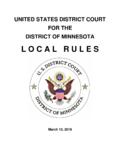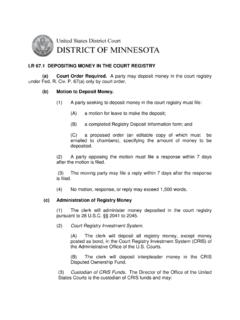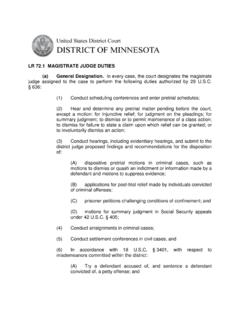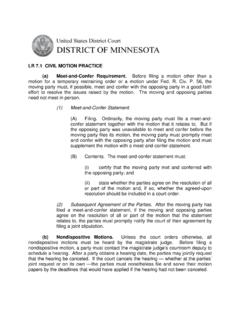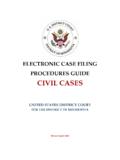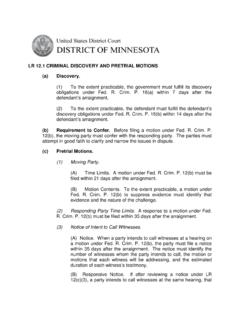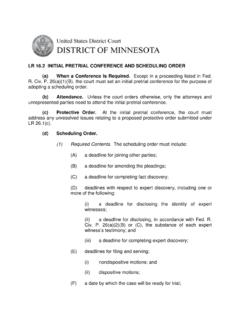Transcription of Pro Se Civil Guidebook - United States District Court
1 United States District Court . District OF MINNESOTA. PRO SE Civil Guidebook . April 2017. This Guidebook is intended to be an informative and practical resource for understanding the basic procedures of the Court . The statements in this Guidebook do not constitute legal advice and may not be cited as legal authority. This Guidebook does not take the place of the Federal Rules, this Court 's Local Rules, or the individual practices of the Judges of this Court . All parties using this Guidebook remain responsible for complying with all applicable rules of procedure. If there is any conflict between this Guidebook and the applicable rules, the rules govern. District Court , District of Minnesota INTRODUCTION. Before you decide to represent yourself in federal Court , there are a number of things you should consider.
2 First, it is challenging and time consuming to represent yourself. In addition to knowing the area of law that is the subject of your lawsuit, there are many rules that have to be followed every step of the way, and failure to follow the rules can have serious consequences. If you cannot afford a lawyer, you may want to look for a lawyer who will represent you pro bono, which means without charge. This Court 's website has a list of organizations you may contact to try to find a lawyer to represent you pro bono. You should be aware that there is no right to a Court - appointed lawyer in a Civil case. Second, there are costs associated with a lawsuit. You will have to pay these costs even if the Court waives the filing fee and the Marshals Service serves your summons and complaint for you.
3 Those costs may include postage, copying costs, and deposition and transcript costs. If you lose your case, the winning party is entitled to a cost judgment against you for certain costs. For more information about costs that you may have to pay if you lose your case, see Federal Rule of Civil Procedure 54; 28 1920; and the Court 's Bill of Costs Guide. The potential of having a cost judgment entered against you is another reason why you may want to discuss your case with a lawyer before deciding to represent yourself in a Civil action. This Guidebook is intended to assist you with the procedures you must follow if you decide to represent yourself in this Court . You cannot rely on this Guidebook alone, however, because it does not cover every situation that may arise in your case, District Court , District of Minnesota and because this Guidebook does not offer any legal advice or information about the specific issues in your lawsuit.
4 You must be prepared to do your own legal research beyond the assistance offered in this Guidebook . There is a list of online research resources on this Court 's website which may be helpful to you in performing legal research. The Court encourages you to carefully review this Guidebook together with the Federal Rules of Civil Procedure and the Court 's Local Rules as you proceed with your case. This Guidebook is generally organized in the order that a typical case proceeds through the Court . It is set up in a question and answer format, so you may skip to the particular question you have. The Table of Contents includes each question that this Guidebook addresses. It may be helpful to start by reviewing the Table of Contents. There are two types of judges in this Court : magistrate judges, and District judges.
5 When you file your case, both a magistrate judge and a District judge will be assigned to your case. The differences between magistrate judges and District judges are explained in Chapter Three of this Guidebook . The words judge or presiding judge may refer to either a magistrate judge or District judge. Meeting the deadlines that will be set by the judge in your case is very important. This Guidebook sets out the various deadlines you will have to be aware of and comply with throughout the course of your lawsuit. To understand how to count the number of days to determine when something is due, you should refer to Federal Rule of Civil Procedure 6. District Court , District of Minnesota TABLE OF CONTENTS. CHAPTER ONE: GENERAL INFORMATION ..6. What rules do I have to follow in this Court ?
6 6. What is the Clerk's Office? .. 7. What does it mean to file and serve documents? .. 8. Are there requirements to file documents with the Clerk's Office? .. 9. CHAPTER TWO: CASE INITIATION ..10. HOW DO I START A LAWSUIT? .. 10. HOW DO I WRITE A COMPLAINT? .. 10. Where can I get a complaint form?.. 11. What information needs to be in a complaint? .. 11. What is a caption page?.. 12. What do I do if I want a jury trial? .. 12. How do I identify the parties in the complaint?.. 12. What is a jurisdictional statement?.. 13. What is venue? .. 14. How do I organize the facts in my complaint? .. 15. How much detail should I include in the complaint? .. 15. What is a count in a complaint? .. 16. What is a request for relief? .. 16. Why do I have to sign the complaint?
7 17. Can I file attachments with my complaint? .. 17. How quickly do I need to file a complaint? .. 18. What are the consequences if something in the complaint is not true? .. 18. HOW DO I FILE MY COMPLAINT? .. 19. What is a Civil cover sheet? .. 20. How can I pay the filing fee? .. 20. What if I cannot afford the fee for filing a new complaint? .. 20. WHAT DO I DO AFTER I FILE MY COMPLAINT? .. 21. How do I obtain a summons for service of process? .. 22. How do I serve my summons and complaint if I am proceeding IFP?.. 22. CAN I CHANGE OR AMEND THE COMPLAINT AFTER I FILE IT? .. 22. HOW DO I SERVE MY SUMMONS AND COMPLAINT? .. 24. How do I get the defendant to waive service of the summons and complaint? .. 24. What if I requested a waiver of service and the defendant does not send it back?
8 26. How do I obtain personal service on a defendant?.. 26. How do I serve a summons and complaint on individuals? .. 27. How do I serve a summons and complaint on a business? .. 27. How do I serve a summons and complaint on the United States , its agencies, corporations, officers, or employees?.. 27. How do I serve a summons and complaint on a state or local government? .. 29. 1. District Court , District of Minnesota Is there a time limit for serving the summons and complaint?.. 29. What is a proof of service? .. 30. HOW DO THE PROCEDURES FOR JUDICIAL REVIEW OF SOCIAL SECURITY. CASES DIFFER FROM OTHER CASES? .. 30. CHAPTER THREE: ANSWERS, COUNTERCLAIMS, MOTIONS, BRIEFS, AND SUPPORTING DOCUMENTS ..32. AFTER THE COMPLAINT HAS BEEN SERVED ON THE DEFENDANT, WHAT.
9 HAPPENS NEXT? .. 32. What does a magistrate judge do?.. 32. How much time does a defendant have to respond to a complaint? .. 33. What type of response to the complaint is required? .. 35. What are the requirements for preparing an answer to a complaint? .. 35. Can the defendant make claims against the plaintiff in the answer? .. 36. Can the defendant amend the answer after filing it? .. 37. Once the answer is filed, does the plaintiff have to file a response to it? .. 38. What are the requirements for counterclaims?.. 38. Once a counterclaim is filed, does the plaintiff have to respond to it? .. 39. CAN A DEFENDANT FILE A MOTION TO CHALLENGE THE COMPLAINT (OR. A PLAINTIFF TO CHALLENGE A COUNTERCLAIM)? .. 40. What is a motion to dismiss the complaint? .. 40. What happens after the judge decides the Rule 12 motion?
10 41. What is a motion for a more definite statement? .. 42. What is a motion to strike? .. 43. WHAT DOES IT MEAN TO WIN BY DEFAULT JUDGMENT? .. 43. HOW DO I FILE MOTIONS, BRIEFS AND SUPPORTING DOCUMENTS WITH THE. Court ?.. 45. Does the Court require a specific format for documents? .. 45. How do I file electronically? .. 46. What kinds of fees and other costs do I have to pay to the Court ? .. 46. WHAT IS A MOTION, AND HOW DO I WRITE OR RESPOND TO ONE? .. 47. What are the requirements for motion papers? .. 48. What do I have to do before filing a motion? .. 49. What is a notice of hearing?.. 52. What is a motion?.. 52. What is a memorandum of law? .. 52. What are affidavits and exhibits? .. 53. What is a meet-and-confer statement? .. 53. What is a proposed order?
